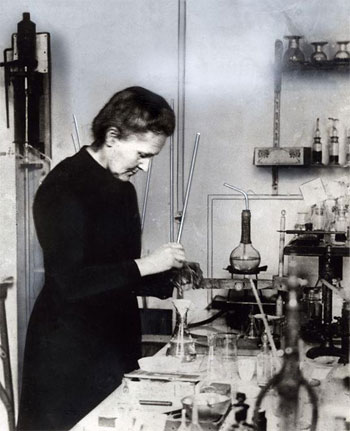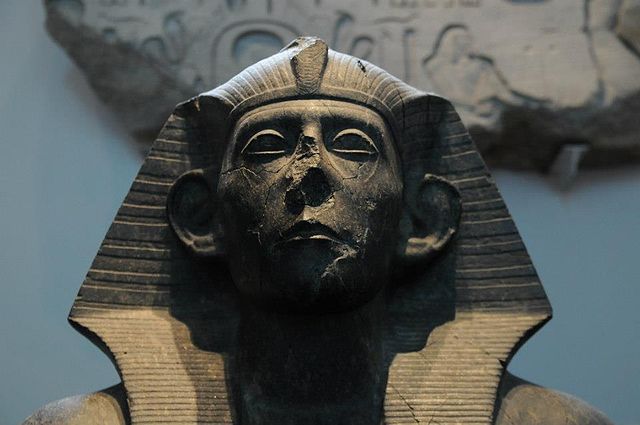Chapters
- 1. Height and weight
- 2. Uses of the SI
- 3. Numbers and letters
- 4. Plain geometry
- 5. Circles
- 6. Compound interest
- 7. Population growth
- 8. Solid geometry
- 9. Molecules
- 10. Radioactive decay
- 11. Pressures
- 12. Gene frequency
- 13. Energy
- 14. Summary
Sections
Radioactive decay
Some natural processes show an exponential decrease, rather than an increase. An important type of exponential decrease is shown by the decay rate of radioactive materials.
Element number 84, the first radioactive element, was discovered by Marie Curie, a Polish chemist working in Paris. She named it Polonium. All of the elements from 84 to 92 are radioactive, which means that they are unstable, and break down spontaneously, emitting particles and rays. The atoms disintegrate on a predictable schedule, not according to the age of individual atoms, but according to the total present at any moment. The decay process is a statistical process, which can be described by equations like the population growth equations, but with a negative rate constant.
The first radioactive element isolated was radium, separated from uranium ore by Marie (Fig. 10-1) and Pierre Curie in 1898. (Pierre taught her French, and she taught him Polish.) The decay process is symbolized by:
88Ra226 -----> 86Rn222 + α
The products are a radon atom and an alpha particle, which consists of 2 protons and 2 neutrons, thus accounting for both the decrease of 2 in atomic number and the decrease of 4 in atomic weight.The rate of decay is:
dN/dt = λN
N is number of atoms; λ is a rate constant that is negative.
The same rearrangement and integration used in Chapter 7 yields:
λ = (ln Nt- ln N0) / Δt
The decay constant can be calculated from the weight of the Curie sample, which was originally 200.0 mg, and 100 years later weighed 191.62 mg.
= (ln 191.62 - ln 200.0) / 100y = - 0.042803122 / 100y = -0.00042803122/y = - 4.28 X 10-4/y
The decay constant is an important factor in the use of radioactivity in tracer experiments, radiation therapy, and dating of ancient artifacts. Another useful constant is called the half-life, which applies to a chemist who needs to get a life. No, not really. It is the time to lose one-half of the original radioactivity, and is related to the decay constant. For the radium sample, the calculation is:
t1/2 = ln 0.5/ λ = - 0.69314718 / - 4.28 X 10-4 = 1620 years
All of the atoms of a single element are not identical. They all have the same number of protons and electrons, and therefore the same atomic number, and the same chemistry. However, variation in the number of neutrons results in different kinds of atoms of the same element, called isotopes. For example, most carbon atoms are C-12, but there are three other isotopes. The abundances are 12 = 98.9%, the heavy isotope C13 = 1.1 %, and very small quantities of C11 and C14, both radioisotopes.
C-11 has been produced from boron by bombardment with deuterons in a cyclotron. The reaction is symbolized by:
5B10 (d,n) 6C11
C11 decays back to boron, and the emitted positron can be detected by the appropriate radiation counter. Until the atoms disintegrate, they behave chemically just like ordinary C-12 carbon.
C11 -----> B11 + β+
Exercise 10-1.
The decay constant of C11 is λ= - 0.0340/ min. Calculate the half-life.
This result indicates that experiments with C11 must be completed quickly, or the radioactivity will decay to the point where there is too little to measure. The general rule is a limit of 8 times the half-life, in this case only 2 hours 43 minutes. On the other hand, C14
Small amounts of C14 are continuously produced in the atmosphere by cosmic-ray bombardment of nitrogen. C-14 is produced in the laboratory by irradiation of N-14 with neutrons in a nuclear reactor, by the same n,p reaction.
7N 14 (n,p) 6C14
(The subscript numbers 7 and 6 are superfluous, because every chemist knows that nitrogen is element 7 and carbon is element 6.) The decay is by emission of beta particles, which are fast-moving electrons:
C14-----> N14+ β-
Carbon-14 has been extremely useful in tracing pathways of metabolism, especially in photosynthesis studies, and in some aspects of medical research.
Important to archeologists was the use of C-14 by Willard F. Libby to determine the age of prehistoric artifacts. This radioactive isotope is present at very low concentration in the CO2 of the air. Carbon dioxide is used by plants to make sugars, starches, and cellulose. C-14 enters the bodies of animals that eat plants. When living things die, they are removed from the carbon cycle, the C14 is no longer replenished, and it continues to decay. Thus, the samples of ancient wood, charcoal, and bone have less radioactivity than modern materials. Special apparatus, consisting of very sensitive detectors and heavy shielding, were built to record these extremely low levels of radiation.
Exercise 10-2.
Given the half-life of C-14 as 5730 years, calculate the decay constant.
Radioactive dating
The decay constant λ can be used in the same way as the growth constant r in the population-growth equation, to calculate age of the sample counted:
The basic equation describing the process is:
Δt = (ln Nt - ln N0) / λ
For example, a sample of charcoal taken in 2000 from the late Neolithic Stonehenge site (Fig. 10-2) had C14 radioactivity = 7.96 counts per minute (c/m) per gram carbon. Modern samples of material from living organisms average 13.56 c/m per g C.
Δt = (ln 7.96 - ln 13.56) / - 0.000120968/ y = -0.532695282/ - 0.000120968/y
= 4 403.6 years before present
This makes the age of the Stonehenge site:
2000 - 4 404 = 2404 BC.
The Lascaux cave in the Dordogne region of France has many paintings made by a Paleolithic artist, including the long-extinct bison.
Exercise 10-3.
Using the modern radioactivity figure above, find the age of a sample of bone from the Lascaux cave that had 2.075 c/m per g C.
Civilization had developed in Mesopotamia and Egypt long before Stonehenge, but some of the artifacts are less ancient. The funerary boat of Sesostris III (Fig. 10-3) was found in his burial chamber inside the pyramid near Dahshur, Egypt. A piece of wood, probably cedar, from the boat was obtained from the Chicago Natural History Museum by Dr. Lilly in 1949, and was analyzed for C-14 age.
Exercise 10-4.
Assuming 13.56 dpm/g C for modern wood, and 8.56 for the sample, calculate age of the boat.
Willard F. Libby received a Nobel prize in 1960, published a book on radiocarbon dating in 1965, and died in 1980.
The C-14 method cannot be used for dating fossils, remains of organisms that lived millions of years ago. Some of these have been dated by the K40 method. Many minerals contain potassium, and are found in the sedimentary rocks in which fossils are embedded. K40 has two decay products, Ca40 and Ar40 , so the analysis is complicated, requiring assumptions about the original quantity of K. Data from mass spectrometer analysis of a sample of mica from the Cambrian indicates N0 = 0.0741mg of K40, and present Nt = 0.0541mg. The decay constant is: λ = 5.501 X 10-10 / y.
Δt = (ln 0.0541 - ln 0.0741) / 5.501 X 10-10/ y = 0.0571862 X 1010 y
= 570 X 106 = 570 million years
Geologists agree that this is the correct age for the Cambrian, the earliest period with abundant animal fossils. About half of the known Cambrian fossils are trilobites, beautiful marine animals that became totally extinct in the Permian period.
Exercise 10-5.
With the value of λ above, calculate the age of the trilobite Ctenopyge from rock that now contains 0.05490 mmol K40, and originally contained 0.07308 mmol.
The time scale of the geological periods and epochs has been established through the use of radioactive elements of known half-life.
Ocean sunlight
The decrease in sunlight with ocean depth also proceeds exponentially, as if each successive tiny layer were absorbing the same small fraction of light reaching it from above. Here are measured fractions of blue-green light at various depths:
| surface | 1.0 |
|---|---|
| 5 m | 0.581 |
| 10 m | 0.338 |
| 21.2 | 0.100 |
| 42.4 | 0.010 |
| 50.4 | 0.0042 |
| 63.5 | 0.0010 |
Exercise 10-5.
Exercise 10-6. Draw a graph of fractional light intensity (y) vs depth in meters (x). Calculate a decay constant from the fractions at 10m and 21.2m.
Population decline
Survival of humans decreases rapidly after age 75. A college alumni directory contains the names of all male alumni from each class. From this list, and the number of those whose deaths have been reported, an average fraction of those surviving to each year can be calculated.
| age | fraction living | age | fraction living |
|---|---|---|---|
| 25 | 1.0 | 80 | 0.3962 |
| 35 | 1.0 | 83 | 0.2586 |
| 47 | 0.9766 | 91 | 0.1304 |
| 60 | 0.9296 | 97 | 0.0385 |
| 68 | 0.867 | 100 | 0.02564 |
| 76 | 0.7857 | 108 | 0.01613 |
| 78 | 0.4925 | 110 | 0 |
Exercise 10-7.
Draw a graph of fraction living (y) vs age (x), then a second graph of ln y vs x.
Note the similarity between the graph of light in the ocean and the graph of survival after age 76.






